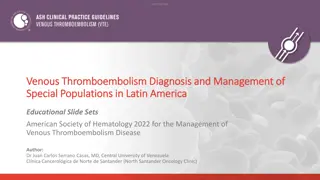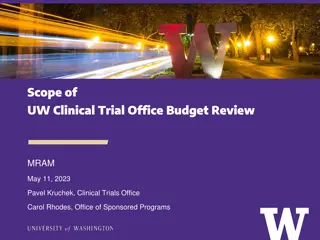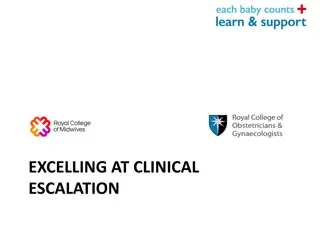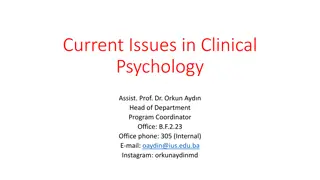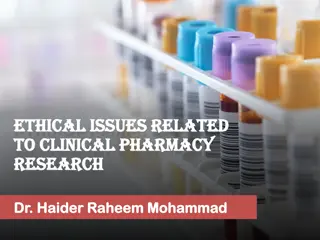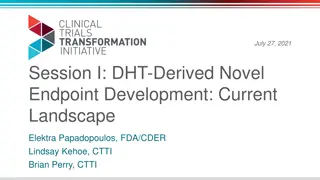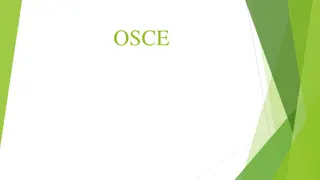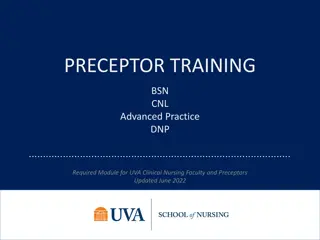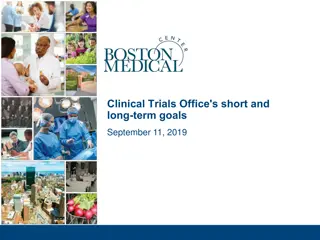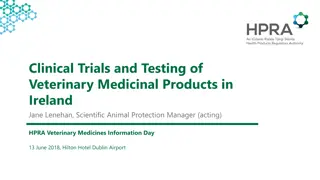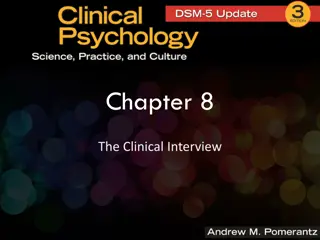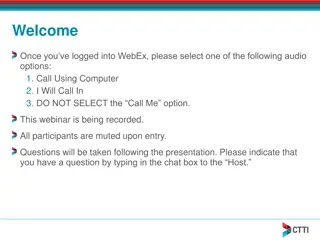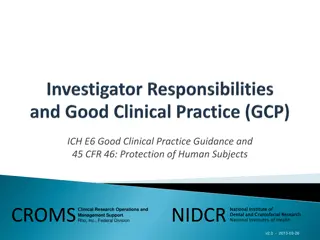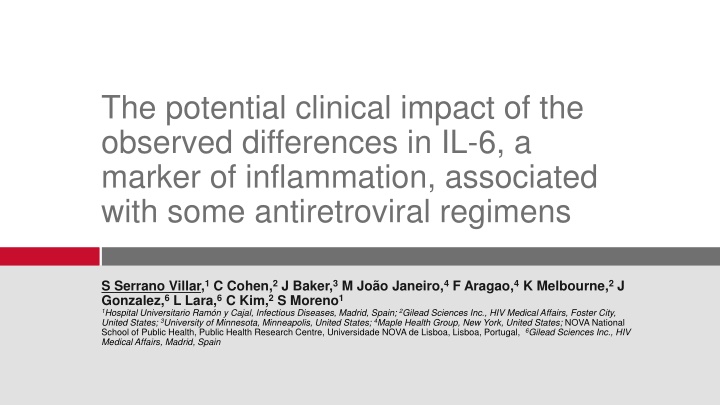
Clinical Impact of IL-6 Variability Associated with Antiretroviral Regimens
Explore the potential clinical impact of differences in IL-6 levels linked to various antiretroviral regimens for people living with HIV. Discover insights from studies like TANGO and SALSA, highlighting the significance of inflammatory markers like IL-6 in guiding treatment decisions and predicting non-AIDS events. Gain valuable information on how changes in antiretrovirals may influence IL-6 levels and patient outcomes.
Download Presentation

Please find below an Image/Link to download the presentation.
The content on the website is provided AS IS for your information and personal use only. It may not be sold, licensed, or shared on other websites without obtaining consent from the author. If you encounter any issues during the download, it is possible that the publisher has removed the file from their server.
You are allowed to download the files provided on this website for personal or commercial use, subject to the condition that they are used lawfully. All files are the property of their respective owners.
The content on the website is provided AS IS for your information and personal use only. It may not be sold, licensed, or shared on other websites without obtaining consent from the author.
E N D
Presentation Transcript
The potential clinical impact of the observed differences in IL-6, a marker of inflammation, associated with some antiretroviral regimens S Serrano Villar,1C Cohen,2J Baker,3M Jo o Janeiro,4F Aragao,4K Melbourne,2J Gonzalez,6L Lara,6C Kim,2S Moreno1 1Hospital Universitario Ram n y Cajal, Infectious Diseases, Madrid, Spain; 2Gilead Sciences Inc., HIV Medical Affairs, Foster City, United States; 3University of Minnesota, Minneapolis, United States; 4Maple Health Group, New York, United States; NOVA National School of Public Health, Public Health Research Centre, Universidade NOVA de Lisboa, Lisboa, Portugal, Medical Affairs, Madrid, Spain 6Gilead Sciences Inc., HIV
GILEAD: CONFIDENTIAL FOR INTERNAL DISCUSSION ONLY Introduction (1 of 3) Guidelines recommend a variety of two- or three-drug antiretroviral (ARV) regimens (2DRs/3DRs) for treating people living with HIV (PLWH)1,2 Although guideline-recommended 2DRs and 3DRs are virologically effective, further information is warranted about possible differentiating factors In some instances, inflammatory markers, including interleukin-6 (IL-6), differ among some oral 2DRs and 3DRs3 5 (Table 1) Table 1. IL-6 Levels in 2DRs and 3DRs in the TANGO and SALSA Studies Study Switch Change in IL-6 level after switching from 3DR to 2DR TANGO Switch to DTG/3TC vs. continuing a TAF-based regimen Week 48: Statistically significant difference favoring 3DR (P = 0.006)3 Week 96: Numerical difference but not statistically significant4 Week 144: Statistically significant difference favoring 3DR (P = 0.039)5 SALSA Switch to DTG/3TC vs. continuing a variety of 3DRs No difference over 48 weeks of treatment6 2
GILEAD: CONFIDENTIAL FOR INTERNAL DISCUSSION ONLY Introduction (2 of 3) In the AIR study, significant differences between oral 2 and 3DR in IL-6 levels, favoring lower levels on 3DR, increased over years7 (Figure 1) Similar findings were seen with D-dimer and C-reactive protein Changes in inflammatory markers may depend on the antiretrovirals used8,9 SALSA included changes from multiple third agents to DTG which may reduce IL-6 levels11, as well as changes from a 3DR to a 2DR, which may increase IL-6 levels These opposing directions of change may have contributed to the observed results 3
GILEAD: CONFIDENTIAL FOR INTERNAL DISCUSSION ONLY Introduction (3 of 3) Previous analysis of PLWH on suppressive oral ART in three studies performed by the INSIGHT trials network showed that elevated inflammatory markers, in particular IL- 6 and D-dimer, are associated with a higher risk of serious non-AIDS events (SNAEs: cardiovascular, hepatic or renal event, malignancy) and death10 Modelling10 predicts that a 16% increase in IL-6 level may increase the risk of SNA/death by about 16% (Figure 2) TANGO week 483 reported a 16% difference in IL-6 between the arms favoring 3DR 4
GILEAD: CONFIDENTIAL FOR INTERNAL DISCUSSION ONLY Aims To mathematically model whether the differences in IL-6 levels associated with remaining on a 3DR, versus switching to a regimen with a higher IL-6, as seen with data from some current oral 2DRs, may affect clinical outcomes (SNAE/death) in virologically suppressed PLWH The model inputs for IL-6 differences uses data from the TANGO and AIR studies 5
GILEAD: CONFIDENTIAL FOR INTERNAL DISCUSSION ONLY Methods (1 of 4) A Markov model was created using observed differences of higher IL-6 levels in the TANGO3 and AIR6 studies in virologically suppressed PLWH switching from a 3DR to a 2DR We developed a model based on observed variation in IL-6 (trajectories over time) The model used TANGO data for the first 3 years and AIR data for > 3 years This is updated from the model reported in our abstract, which did not have access to TANGO data after week 48 At entry in the model, age was set at 39 years10 and baseline IL-6 levels were divided by quartiles based on the distribution in the AIR study7 cohort The model output was based on published analyses from the INSIGHT trials network, which defined the predicted change in risk of SNAE/death by changes in IL-6 concentration based on data from 3,766 individuals from the virologically suppressed arms of the SMART, ESPRIT and SILCAAT studies10 6
GILEAD: CONFIDENTIAL FOR INTERNAL DISCUSSION ONLY Methods (2 of 4) Markov modelling provides a standard framework for predicting clinical outcomes in terms of transitions between states based on the current state occupied by an individual. Per year, an individual can cycle through the model with no events, a SNAE, and/or death IL-6 categories (quartiles) Low Low-med Med-high High SNAE/ death Death
GILEAD: CONFIDENTIAL FOR INTERNAL DISCUSSION ONLY Methods (3 of 4) Approximate time course of changes in IL-6 concentration that went into the Markov model (based on changes in IL-6 seen in TANGO Week 48, 96, 144 and AIR data) 2DR IL-6 3DR Week 144 Week 48 Week 96 Time Note: Graph is illustrative only of the overall trends inputted into the model, and not intended to reflect the exact data points that were inputted 8
GILEAD: CONFIDENTIAL FOR INTERNAL DISCUSSION ONLY Methods (4 of 4) The primary endpoint of our study was the number needed to treat (NNT) that the model predicts would result in one additional SNAE/death based on the observed changes to IL-6 We also estimated the size of a clinical cohort, including a randomized clinical trial, that would be needed to support or refute this effect 9
GILEAD: CONFIDENTIAL FOR INTERNAL DISCUSSION ONLY Results PLWH maintained on a 3DR spend 22% more time in the "low" IL-6 quartile Those on a 2DR spend 16% more time in the "high" IL-6 category As a result, the mean number of SNAE/death events that are expected to occur for every 100 PLWH over 144 weeks was 5.6 (3DR) vs 6.8 (2DR) 10
GILEAD: CONFIDENTIAL FOR INTERNAL DISCUSSION ONLY Results: Number Needed to Treat (NNT) Based on the model, for every 43 PLWH 30 50 years old treated for 5 years with a regimen associated with higher IL-6, there would be one additional SNAE/death outcome (Figure 3) : NNT=43 NNT of 43: for every 43 PLWH treated with a regimen that has a higher IL-6 for five years, the model predicts there would be one additional SNA/death event 11
GILEAD: CONFIDENTIAL FOR INTERNAL DISCUSSION ONLY Results The NNT varies with years on treatment (Table 2) Table 2. NNT to Observe One Additional SNA/Death Outcome on a 2DR vs. 3DR by Time on ART, Based on the Observed Higher IL-6 Levels With 2DRs Time (years) 3 5 10 NNT 106 43 13 Estimates from Markov modeling considered participant age range of 30-50 years 12
GILEAD: CONFIDENTIAL FOR INTERNAL DISCUSSION ONLY Results Given that these model data suggest an important clinical impact of the elevated IL-6 levels, we estimated the cohort size required to support or refute an effect of this magnitude (Figure 4) Figure 4. Clinical Study Design and Study Size Required to Test the Hypothesis Study design Study size required 2DR vs. 3DR (1:1) over time 144-week study: N = 13,149 Two-sided; significance: 0.05; power: 80% 240-week study: N = 2,906 Outcome: Incidence of SNAE/death 528-week study: N = 324 Note: If unequal sample sizes were used in the study (i.e., not 1:1), then different study sizes are required. For example, for a study including 9,000 PLWH taking a 3DR over 144 weeks, the distribution of patients would need to be about 2:1, i.e., around 5,000 PLWH taking 2DR would need to be included in the study to achieve a power of 0.8. 13
GILEAD: CONFIDENTIAL FOR INTERNAL DISCUSSION ONLY Limitations Only changes to IL-6 were modeled These results are not generalizable beyond the ARV regimens studied in TANGO and AIR More recent two drug regimens, e.g., long acting injectables, have longer half-lives and other differences which may affect the risk of inflammation over time While guidelines1,2 acknowledge the importance of inflammation in PLWH, they cannot provide specific recommendations for the measurement, prevention or treatment of inflammation given a lack of adequately powered trials which address this question 14
GILEAD: CONFIDENTIAL FOR INTERNAL DISCUSSION ONLY Guidelines Current guidelines on inflammation are summarized in Table 3 Table 3. International Guidelines on Inflammation and Immune activation DHHS 20211 EACS 20202 Persistently low CD4 cell counts and immune activation are each associated with increased AIDS- and non AIDS- related morbidity and mortality among individuals with ART-mediated viral suppression Potential contributors to comorbidity pathogenesis include a higher prevalence of recognised risk factors, potential toxicities from ART exposure, and HIV infection (or coinfections with CMV and HCV) contributing to immune dysfunction/dysregulation, chronic immune activation and inflammation Interventions designed to increase CD4 cell counts and/or decrease immune activation are not recommended outside of a clinical trial, because no current interventions have been proven to decrease morbidity or mortality during ART mediated viral suppression CD4/CD8 ratio is a stronger predictor of serious outcomes vs. CD4 count 15
GILEAD: CONFIDENTIAL FOR INTERNAL DISCUSSION ONLY Conclusions Over the long term, higher inflammation may negatively impact clinical outcomes for PLWH Levels of inflammatory markers, including IL-6, have been reported to differ after a switch between antiviral classes as well as from some current 3DRs to some current oral 2DRs Our Markov model suggests that the IL-6 elevation observed with the switch from some 3DRs to some 2DRs may increase the risk of serious non-AIDS events and/or death in PLWH The IL-6 differences observed with the switch would be expected to result in one additional SNAE/death event for every 43 people (age 30-50) treated for 5 years Further studies are warranted to confirm the observed differences If confirmed, long-term clinical studies may help optimize care given the concerns raised here A 240-week study with approximately 2900 participants would be required to evaluate this clinically 16
GILEAD: CONFIDENTIAL FOR INTERNAL DISCUSSION ONLY References DHHS Guidelines for the Use of Antiretroviral Agents in Adults and Adolescents with HIV. June 2021. https://clinicalinfo.hiv.gov/sites/default/files/guidelines/documents/AdultandAdolescentGL.pdf (accessed Sep 2021) 1. EACS Guidelines version 10.1, Oct 2020. https://www.eacsociety.org/media/guidelines-10.1_30032021_1.pdf (accessed Sep 2021) 2. van Wyk JJ, et al. Clin Infect Dis 2020;71:1920-1929 3. Wang R, et al. IAS 2021;OAB0301 4. Osiyemi O, et al. ID Week 2021; 900 5. Llibre JM, et al. IAS 2021;OALB0303 6. Serrano-Villar S, et al. AIDS 2020;OAB0304 7. Mart nez E, et al. AIDS 2012;26:2315-2326 8. Trottier B, et al. Antivir Ther 2017;22:295-305 9. Grund B, et al. PLoS One 2016;11:e0155100 10. 11. Hileman CO et al. Curr HIV/AIDS Rep (2017) 14:93 100 17
GILEAD: CONFIDENTIAL FOR INTERNAL DISCUSSION ONLY Acknowledgements This is a collaborative work, funded by Gilead Sciences. We thank the investigators and participants who provided data for the original studies. Medical writing support was provided by Emma McConnell, PhD (Aspire Scientific Limited), and funded by Gilead 18

